Usain Bolt – 2016 Rio Olympics – Illuminati Symbolism – Masonic Ring Exposed! (VIDEO)
John Ale
Masonic Puppet....so it seems...
NOTE: Disregard any NONCATHOLIC teaching
Usain Bolt – 2016 Rio Olympics – Illuminati Symbolism – Masonic Ring EXPOSED. In this video The Vigilant Christian points
out the Illuminati connection and symbolism of Usain Bolt! The world is
a stage and more of it orchestrated than you can imagine.
In several
early Masonic manuscripts–for example, the Harleian, Sloane, Lansdowne,
and Edinburgh-Kilwinning–it is stated that the craft of initiated
builders existed before the Deluge, and that its
members were employed in the building of the Tower of Babel. A Masonic
Constitution dated 1701 gives the following naive account of the origin
of the sciences, arts, and crafts from which the major part of Masonic
symbolism is derived. (Video all the way at the bottom of this blog)
“How this
worthy Science was first begunne, I shall tell. Before Noah’s Flood,
there was a man called Lameck as it is written in the 4 Chap. of Gen.:
and this Lameck had two Wives. The one was called Adah, and the other
Zillah; by the first wife Adah he gott two Sons, the one called Jaball,
and the other Juball, and by the other wife Zillah he got a Son and
Daughter, and the four children found the beginning of all Crafts in the
world. This Jaball was the elder Son, and he found the Craft of
Geometric, and he parted flocks, as of Sheep and Lambs in the fields,
and first wrought Houses of Stone and Tree, as it is noted in the Chap,
aforesaid, and his Brother Juball found the crafte of Musick, of Songs,
Organs and Harp.
The Third
Brother [Tubal-cain] found out Smith’s craft to work Iron and steel, and
their sister Naamah found out the art of Weaving. These children did
know thatt God would take Vengeance for Sinne, either by fire or water,
wherefor they wrote these Sciences which they had found in Two Pillars
of stone, thatt they might be found after the Flood. The one stone was
called Marbell–cannott burn with Fire, and the other was called Laturus
[brass?], thatt cannott drown in the Water.”
The author of
this Constitution there upon declares that one of these pillars was
later discovered by Hermes, who communicated to mankind the secrets
thereon inscribed.
In
his Antiquities of the Jews, Josephus writes that Adam had forewarned
his descendants that sinful humanity would be destroyed by a deluge. In
order to preserve their science and philosophy, the children of Seth
there fore raised two pillars, one of brick and the other of stone, on
which were inscribed the keys to their knowledge. The Patriarch
Enoch–whose name means the Initiator–is evidently a personification of
the sun, since he lived 365 years. He also constructed an underground
temple consisting of nine vaults, one beneath the other, placing in the
deepest vault a triangular tablet of gold bearing upon it the absolute
and ineffable Name of Deity.
According to
some accounts, Enoch made two golden deltas. The larger he placed upon
the white cubical altar in the lowest vault and the smaller he gave into
the keeping of his son, Methuseleh, who did the actual construction
work of the brick chambers according to the pattern revealed to his
father by the Most High. In the form and arrangement of these vaults
Enoch epitomized the nine spheres of the ancient Mysteries and the nine
sacred strata of the earth through which the initiate must pass to reach
the flaming Spirit dwelling in its central core.
According to
Freemasonic symbolism, Enoch, fearing that all knowledge of the sacred
Mysteries would be lost at the time of the Deluge, erected the two
columns mentioned in the quotation. Upon the metal column in appropriate
allegorical symbols he engraved the secret reaching and upon the marble
column placed an inscription stating that a short distance away a
priceless treasure would be discovered in a subterranean vault. After
having thus faithfully completed his labors, Enoch was translated from
the brow Of Mount Moriah. In time the location of the secret vaults was
lost, but after the lapse of ages there came another builder–an initiate
after the order of Enoch–and he, while laying the foundations for
another temple to the Great Architect of the Universe, discovered the
long-lost vaults and the secrets contained within.
John Leylande
was appointed by King Henry VIII to go through the archives of the
various religious institutions dissolved by the king and remove for
preservation any books or manuscripts of an important character. Among
the documents copied by Leylande was a series of questions and answers
concerning the mystery of Masonry written by King Henry VI. In answer to
the question, “How came Masonry into England?” the document States that
Peter Gower, a Grecian, traveled for knowledge in Egypt, Syria, and
every land where the Phœnicians had planted Masonry; winning entrance in
all lodges of Masons, he learned much, and returning, dwelt in Greater
Greece. He became renowned for his wisdom, formed a great lodge at
Groton, and made many Masons, some of whom journeyed in France,
spreading Masonry there; from France in the course of time the order
passed into England.
To even the
superficial student of the subject it must be evident that the name
of Peter Gower, the Grecian, is merely an Anglicized form of Pythagoras;
consequently Groton, where he formed his lodge, is easily identified
with Crotona. A link is thus established between the philosophic
Mysteries of Greece and mediæval Freemasonry. In his notes on King
Henry’s questions and answers, William Preston enlarges upon the vow of
secrecy as it was practiced by the ancient initiates.
On the
authority of Pliny he describes how Anaxarchus, having been imprisoned
in order to extort from him some of the secrets with which he had been
entrusted, bit out his own tongue and threw it in the face of Nicocreon,
the tyrant of Cyprus. Preston adds that the Athenians revered a brazen
statue that was represented without a tongue to denote the sanctity with
which they regarded their oath-bound secrets. It is also noteworthy
that, according to King Henry’s manuscript, Masonry had its origin in
the East and was the carrier of the arts and sciences of civilization to
the primitive humanity of the western nations.
Conspicuous
among the symbols of Freemasonry are the seven liberal arts and
sciences. By grammar man is taught to express in noble and adequate
language his innermost thoughts and ideals; by rhetoric he is enabled to
conceal his ideals under the protecting cover of ambiguous language and
figures of speech; by logic he is trained

Redrawn from Cesariano’s Edition of Vitruvius.
Summarizing the relationship between the human body and the theory of architectonics, Vitruvius writes:
“Since nature
has designed the human body so that its members are duly proportioned
to the frame as a whole, it appears that the ancients had good reason
for their rule, that in perfect building the different members must be
in exact symmetrical relations to the whole general scheme. Hence, while
transmitting to us the proper arrangements for buildings of all kinds,
they were particularly careful to do so in the case of temples of the
gods, buildings in which merits and faults usually last forever. * * *
Therefore, if it is agreed that number was found out from the human
fingers, and that there is a symmetrical correspondent between the
members separately and the entire form of the body, in accordance with a
certain part selected as standard, we can have nothing but respect for
those who, in constructing temples of the immortal gods, have so
arranged the members of the works that both the separate parts and the
whole design may harmonize in their proportions and symmetry.” (See The
Ten Books on Architecture)
By some it is
believed that St. Paul was initiated into the Dionysiac Mysteries, for
in the tenth verse of the third chapter of First Corinthians he calls
himself a “master-builder” or adept: “According to the grace of God
which is given into me, as a wise master-builder, I have laid the
foundation and another buildeth thereon. ” As survivals of the ancient
Dionysiac rites, the two diagrams of Cesariano, accompanying this
chapter are of incalculable value to the modern mystic architect.
in the
organization of the intellectual faculties with which he has been
endowed; by arithmetic he not only is instructed in the mystery of
universal order but also gains the key to multitude, magnitude, and
proportion; by geometry he is inducted into the mathematics of form, the
harmony and rhythm of angles, and the philosophy of organization;
by music he is reminded that the universe is founded upon the laws of
celestial harmonics and that harmony and rhythm are all-pervading;
by astronomy he gains an understanding of the immensities of time and
space, of the proper relationship between himself and the universe, and
of the awesomeness of that Unknown Power which is driving the countless
stars of the firmament through illimitable space. Equipped with the
knowledge conferred by familiarity with the liberal arts and sciences,
the studious Freemason therefore finds himself confronted by few
problems with which he cannot cope.
THE DIONYSIAC ARCHITECTS
The most
celebrated of the ancient fraternities of artisans was that of the
Dionysiac Architects. This organization was composed exclusively of
initiates of the Bacchus-Dionysos cult and was peculiarly consecrated to
the science of building and the art of decoration. Acclaimed as being
the custodians of a secret and sacred knowledge of architectonics, its
members were entrusted with the design and erection of public buildings
and monuments. The superlative excellence of their handiwork elevated
the members of the guild to a position of surpassing dignity; they were
regarded as the master craftsmen of the earth.
Because of
the first dances held in honor of Dionysos, he was considered the
founder and patron of the theater, and the Dionysians specialized in the
construction of buildings adapted for the presentation of dramatic
performances. In the circular or semicircular orchestra they invariably
erected an altar to Æschylus, the famous Greek poet, that while
appearing in one of his own plays he was suspected by a mob of angry
spectators of revealing one of the profound secrets of the Mysteries and
was forced to seek refuge at the altar of Dionysos.
So carefully
did the Dionysiac Architects safeguard the secrets of their craft that
only fragmentary records exist of their esoteric teachings. John A.
Weisse thus sums up the meager data available concerning the order:
“They made
their appearance certainly not later than 1000 B.C., and appear to have
enjoyed particular privileges and immunities. They also possessed secret
means of recognition, and were bound together by special ties only
known to themselves. The richer of this fraternity were bound to provide
for their poorer brethren. They were divided into communities, governed
by a Master and Wardens, and called γυνοικιαι (connected houses). They
held a grand festival annually, and were held in high esteem. Their
ceremonials were regarded as sacred. It has been claimed that Solomon,
at the instance of Hiram, King of Tyre, employed them at his temple and
palaces. They were also employed at the construction of the Temple of
Diana at Ephesus. They had means of intercommunication all over the then
known world, and from them, doubtless, sprang the guilds of the
Traveling Masons known in the Middle Ages.” (See The Obelisk and
Freemasonry.)
The
fraternity of the Dionysiac Architects spread throughout all of Asia
Minor, even reaching Egypt and India. They established themselves in
nearly all the countries bordering on the Mediterranean, and with the
rise of the Roman Empire found their way into Central Europe and even
into England. The most stately and enduring buildings in Constantinople,
Rhodes, Athens, and Rome were erected by these inspired craftsmen. One
of the most illustrious of their number was Vitruvius, the great
architect, renowned as the author of De Architectura Libri Decem. In the
various sections of his book Vitruvius gives several hints as to the
philosophy underlying the Dionysiac concept of the principle of symmetry
applied to the science of architecture, as derived from a consideration
of the proportions established by Nature between the parts and members
of the human body. The following extract from Vitruvius on the subject
of symmetry is representative:
“The design
of a temple depends on symmetry, the principles of which must be most
carefully observed by the architect. They are due to proportion, in
ἀναλογία. Proportion is a correspondence among the measures of the
members of an entire work, and of the whole to a certain part selected
as standard. From this result the principles of symmetry. Without
symmetry and proportion there can be no principles in the design of any
temple; that is, if there is no precise relation between its members, as
in the case of those of a well shaped man.
For the human
body is so designed by nature that the face, from the chin to the top
of the forehead and the lowest roots of the hair, is a tenth part of the
whole height; the open hand from the wrist to the tip of the middle
finger is just the same; the head from the chin to the crown is an
eighth, and with the neck and shoulder from the top of the breast to the
lowest roots of the hair is a sixth; from the middle of the breast to
the summit of the crown is a fourth. If we take the height of the face
itself, the distance from the bottom of the chin to the under side of
the nostrils [and from that point] to a line between the eyebrows is the
same; from there to the lowest roots of the hair is also a third,
comprising the forehead.
The length of
the foot is one sixth of the height of the body; of the forearm, one
fourth; and the breadth of the breast is also one fourth. The other
members, too, have their own symmetrical proportions, and it was by
employing them that the famous painters and sculptors of antiquity
attained to great and endless renown.”
The edifices
raised by the Dionysiac Builders were indeed “sermons in stone.” Though
unable to comprehend fully the cosmic principles thus embodied in these
masterpieces of human ingenuity and industry, even the uninitiated were
invariably overwhelmed by the sense of majesty and symmetry resulting
from the perfect coordination of pillars, spans, arches, and domes. By
variations in the details of size, material, type, arrangement,
ornamentation, and color, these inspired builders believed it possible
to provoke in the nature of the onlooker certain distinct mental or
emotional reactions. Vitruvius, for example, describes the disposition
of bronze vases about a room so as to produce certain definite changes
in the tone and quality of the human voice. In like manner, each chamber
in the Mysteries through which the candidate passed had its own
peculiar acoustics.
Thus in one
chamber the voice of the priest was amplified until his words caused the
very room to vibrate, while in another the voice was diminished and
softened to such a degree that it sounded like the distant tinkling of
silver bells. Again, in some of the underground passageways the
candidate was apparently bereft of the power of speech, for though he
shouted at the top of his voice not even a whisper was audible to his
ears. After progressing a few feet, however, he would discover that his
softest sigh would be reechoed a hundred times.
The supreme
ambition of the Dionysiac Architects was the construction of buildings
which would create distinct impressions consistent with the purpose for
which the structure itself was designed. In common with the
Pythagoreans, they believed it possible by combinations of straight
lines and curves to induce any desired mental attitude or emotion. They
labored, therefore, to the end of producing a building perfectly
harmonious with the structure of the universe itself.
They may have
even believed that an edifice so constructed because it was in no
respect at variance with any existing reality would not be subject to
dissolution but would endure throughout the span of mortal time. As a
logical deduction from their philosophic trend of thought, such a
building–en rapport with Cosmos–would also have become an oracle.
Certain early works on magical philosophy hint that the Ark of the
Covenant was oracular in character because of specially prepared
chambers in its interior.
These by
their shape and arrangement were so attuned to the vibrations of the
invisible world that they caught and amplified the voices of the ages
imprinted upon and eternally existent in the substance of the astral
light.
Unskilled in
these ancient subtleties of their profession, modern architects often
create architectural absurdities which would cause their creators to
blush with shame did they comprehend their actual symbolic import. Thus,
phallic emblems are strewn in profusion among the adornments of banks,
office buildings, and department stores. Christian churches also may be
surmounted with Brahmin or Mohammedan domes or be designed in a style
suitable for a Jewish synagogue or a Greek temple to Pluto.
These
incongruities may be considered trivial in importance by the modern
designer, but to the trained psychologist the purpose for which a
building was erected is frustrated in large measure by the presence of
such architectural discordances. Vitruvius thus defines the principle of
propriety as conceived and applied by the Dionysians:
“Propriety is
that: perfection of style which comes when a work is authoritatively
constructed on approved principles. It arises from prescription (Greek
θεματισμῷ), from usage, or from nature. From prescription, in the case
of hypæthral edifices, open to the sky, in honour of Jupiter Lightning,
the Heaven, the Sun, or the Moon: for these are gods whose semblances
and manifestations we behold before our very eyes in the sky when it is
cloudless and bright. The temples of Minerva, Mars, and Hercules will be
Doric, since the virile strength of these gods makes daintiness
entirely inappropriate to their houses.
In temples to
Venus, Flora, Proserpine, Spring-Water, and the Nymphs, the Corinthian
order will be found to have peculiar significance, because these are
delicate divinities and so its rather slender outlines, its flowers,
leaves, and ornamental volutes will lend propriety where it is due. The
construction of temples of the Ionic order to Juno, Diana, Father
Bacchus, and the other gods of that kind, will be in keeping with the
middle position which they hold; for the building of such will be an
appropriate combination of the severity of the Doric and the delicacy of
the Corinthian.”
In describing
the societies of Ionian artificers, Joseph Da Costa declares the
Dionysiac rites to have been founded upon the science of astronomy,
which by the initiates of this order was correlated to the builder’s
art. In various documents dealing with the origin of architecture are
found hints to the effect that the great buildings erected by these
initiated craftsmen were based upon geometrical patterns derived from
the constellations.
Thus, a
temple might be planned according to the constellation of Pegasus or a
court of judgment modeled after the constellation of the Scales. The
Dionysians evolved a peculiar code by which they were able to
communicate with one another in the dark and both the symbols and the
terminology of their guild were derived, in the main, from the elements
of architecture.
While
stigmatized as pagans by reason of their philosophic principles, it is
noteworthy that these Dionysiac craftsmen were almost universally
employed in the erection of early Christian abbeys and cathedrals, whose
stones even to this very day bear distinguishing marks and symbols cut
into their surfaces by these illustrious builders.
Among the
ornate carvings upon the fronts of great churches of the Old World are
frequently found representations of compasses, squares, rules, mallets,
and clusters of builders’ tools skillfully incorporated into mural
decorations and even placed in the hands of the effigies of saints and
prophets standing in exalted niches.
A great
mystery was contained in the ancient portals of the Cathedral Of Notre
Dame which were destroyed during the French Revolution, for among their
carvings were numerous Rosicrucian and Masonic emblems; and according to
the records preserved by alchemists who studied their bas-reliefs, the
secret processes for metallic transmutation were set forth in their
grotesque yet most significant figures.
The
checkerboard floor upon which the modern Freemasonic lodge stands is the
old tracing board of the Dionysiac Architects, and while the modern
organization is no longer limited to workmen’s guilds it still preserves
in its symbols the metaphysical doctrines of the ancient society of
which it is presumably the outgrowth. The investigator of the origin of
Freemasonic symbolism who desires to trace the development of the order
through the ages will find a practical suggestion in the following
statement of Charles W. Heckethorn:
“But
considering that Freemasonry is a tree the roots of which spread through
so many soils, it follows that traces thereof must be found in its
fruit; that its language and ritual should retain much of the various
sects and institutions it has passed through before arriving at their
present state, and in Masonry we meet with Indian, Egyptian, Jewish, and
Christian ideas, terms therefrom the supreme ambition of their craft
and symbols.” (SeeThe Secret Societies of All Ages and Countries.)
The
Roman Collegia of skilled architects were apparently a subdivision of
the greater Ionian body, their principles and organization being
practically identical with the older Ionian institution. It has been
suspected that the Dionysians also profoundly influenced early Islamic
culture, for part of their symbolism found its way into the Mysteries of
the dervishes. At one time the Dionysians referred to themselves as
Sons of Solomon, and one of the most important of their symbols was the
Seal of Solomon–two interlaced triangles.
This motif is
frequently seen in conspicuous parts of Mohammedan mosques. The Knights
Templars–who were suspected of anything and everything–are believed to
have contacted these Dionysiac artificers
and to have introduced many of their symbols and doctrines into
mediæval Europe. But Freemasonry most of all owes to the Dionysiac cult
the great mass of its symbols and rituals which are related to the
science of architecture. From these ancient and illustrious artisans it
also received the legacy of the unfinished Temple of Civilization-that
vast, invisible structure upon which these initiated builders have
labored continuously since the inception of their fraternity. This
mighty edifice, which has fallen and been rebuilt time after time but
whose foundations remain unmoved, is the true Everlasting House of which
the temple on the brow of Mount Moriah was but an impermanent symbol.
Aside from
the operative aspect of their order, the Dionysiac Architects had a
speculative philosophic code. Human society they considered as a rough
and untrued ashlar but lately chiseled from the quarry of elemental
Nature. This crude block was the true object upon which these skilled
craftsmen labored–polishing it, squaring it, and with the aid of fine
carvings transforming it into a miracle of beauty. While mystics
released their souls from the bondage of matter by meditation and
philosophers found their keenest joy in the profundities of thought,
these master workmen achieved liberation from the Wheel of Life and
Death by learning to swing their hammers with the same rhythm that moves
the swirling forces of Cosmos.
They
venerated the Deity under the guise of a Great Architect and Master
Craftsman who was ever gouging rough ashlars from the fields of space
and truing them into universes. The Dionysians affirmed constructiveness
to be the supreme expression of the soul, and attuning themselves with
the ever-visible constructive natural processes going on around them,
believed immortality could be achieved by thus becoming a part of the
creative agencies of Nature.
SOLOMON, THE PERSONIFICATION OF UNIVERSAL WISDOM
The name
Solomon may be divided into three syllables, SOL-OM-ON, symbolizing
light, glory, and truth collectively and respectively. The Temple of
Solomon is, therefore, first of all “the House of Everlasting Light,”
its earthly symbol being the temple of stone on the brow of Mount
Moriah. According to the Mystery teachings, there are three Temples of
Solomon–as there are three Grand Masters, three Witnesses, and three
Tabernacles of the Transfiguration. The first temple is the Grand House
of the Universe, in the midst of which sits the sun (SOL) upon his
golden throne.
The twelve
signs of the zodiac as Fellow-Craftsmen gather around their shining
lord. Three lights–the stellar, the solar, and the lunar–illuminate this
Cosmic Temple. Accompanied by his retinue of planets, moons, and
asteroids, this Divine King (SOLomon), whose glory no earthly monarch
shall ever equal, passes in stately pomp down the avenues of space.
Whereas CHiram represents the active physical light of the sun, SOLomon
signifies its invisible but all-powerful, spiritual and intellectual
effulgency.
The second
symbolic temple is the human body-the Little House made in the image of
the Great Universal House. “Know ye not,” asked the Apostle Paul, “that
ye are the temple of God, and that the Spirit of God dwelleth in you?”
Freemasonry within a temple of stone cannot be other than speculative,
but Freemasonry within the living temple of the body is operative. The
third symbolic temple is the Soular House, an invisible structure, the
comprehension of which is a supreme Freemasonic arcanum.
The mystery
of this intangible edifice is concealed under the allegory of the Soma
Psuchicon, or Wedding Garment described by St. Paul, the Robes of Glory
of the High Priest of Israel, the Yellow Robe of the Buddhist monk, and
the Robe of Blue and Gold to which Albert Pike refers in his Symbolism.
The soul, constructed from an invisible fiery substance, a flaming
golden metal, is cast by the Master Workman, CHiram Abiff, into the mold
of clay (the physical body) and is called the Molten Sea. The temple of
the human soul is built by three Master Masons personifying Wisdom,
Love, and Service, and when constructed according to the Law of Life the
spirit of God dwells in the Holy Place thereof. The Soular Temple is
the true Everlasting House, and he who can raise
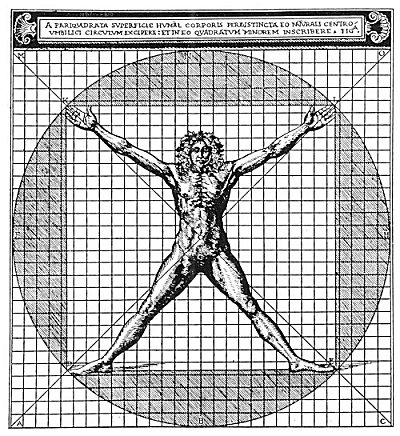
Redrawn from Cesariano’s Edition of Vitruvius.
Herein is
depicted the mysterious Word of Plato which was crucified in space
before the foundation of the world. The anonymous author of The
Canon writes:
“The Logos or
soul of the world, according to Plato, the Greek Hermes, and the
Christ, according to the Christian Gnostics, are all one and the same as
the Hebrew Adam Kadmon, who is the second person of the cabalistic
triad. The Cyllenian Hermes, described by Hippolytus, so exactly
resembles the lesser man found in Cesariano’s edition of Vitruvius, that
they may be justifiably considered to be identical.”
After
relating the figure to Dionysus because of the vine leaves wound in the
hair, the same writer concludes: “Here we have clearly and distinctly a
curious survival of the cosmic deity of Greece, copied and disfigured by
the crude draughtsmen of the Middle Ages, but faithfully preserved, and
recognizable to the last.” Similar figures are to be found in
Agrippa’s De Occulta Philosophia. Like Cesariano’s diagrams, however,
the key given for their interpretation is most inadequate.
Agrippa
declares that, being a type of the lesser world, man contains in himself
all numbers, measures, weights, motions, and elements. The secret
doctrine of Freemasonry, like that of the Dionysiac Architects, is
concerned primarily with the effort to measure or estimate
philosophically the parts and proportions of the microcosm, so that by
the knowledge derived therefrom the supreme ambition of their craft
might be realized–the creation of a perfect man.
or cast it is
a Master Mason indeed! The best-informed Masonic writers have realized
that Solomon’s Temple is a representation in miniature of the Universal
Temple. Concerning this point, A. E. Waite, in A New Encyclopædia of
Freemasonry, writes: “It is macrocosmic in character, so that the Temple
is a symbol of the universe, a type of manifestation itself.”
Solomon, the
Spirit of Universal Illumination–mental, spiritual, moral, and
physical–is personified in the king of an earthly nation. While a great
ruler by that name may have built a temple, he who considers the story
solely from its historical angle will never clear away the rubbish that
covers the secret vaults. The rubbish is interpolated matter in the form
of superficial symbols, allegories, and degrees which have no
legitimate part in the original Freemasonic Mysteries. Concerning the
loss of the true esoteric key to Masonic secrets, Albert Pike writes:
“No one
journeys now ‘from the high place of Cabaon to the threshing floor of
Oman the Yebusite,’ nor has seen, ‘his Master, clothed in blue and
gold;’ nor are apprentices and Fellow-crafts any longer paid at their
respective Columns; nor is the Master’s working tool the Tracing Board,
nor does he use in his work ‘Chalk, Charcoal, and an Earthen Vessel,’
nor does the Apprentice, becoming a Fellow Craft, pass from the square
to the compass; for the meanings of these phrases as symbols have long
been lost.”
According to
the ancient Rabbins, Solomon was an initiate of the Mystery schools and
the temple which he built was actually a house of initiation containing
amass of pagan philosophic and phallic emblems. The pomegranates, the
palm-headed columns, the Pillars before the door, the Babylonian
cherubim, and the arrangement of the chambers and draperies all indicate
the temple to have been patterned after the sanctuaries of Egypt and
Atlantis. Isaac Myer, inThe Qabbalah, makes the following observation:
“The
pseudo-Clement of Rome, writes: ‘God made man male and female. The male
is Christ: the female, the Church.’ The Qabbalists called the Holy
Spirit, the mother, and the Church of Israel, the Daughter. Solomon
engraved on the walls of his Temple, likenesses of the male and female
principles, to adumbrate this mystery; such, it is said, were the
figures of the cherubim. This was, however, not in obedience to the
words of the Thorah. They were symbolical of the Upper, the spiritual,
the former or maker, positive or male, and the Lower, the passive, the
negative or female, formed or made by the first.”
Masonry came
to Northern Africa and Asia Minor from the lost continent of Atlantis,
not under its present name but rather under the general designation Sun
and Fire Worship. The ancient Mysteries did not cease to exist when
Christianity became the world’s most powerful religion. Great Pan did
not die! Freemasonry is the proof of his survival. The pre-Christian
Mysteries simply assumed the symbolism of the new faith, perpetuating
through its emblems and allegories the same truths which had been the
property of the wise since the beginning of the world. There is no true
explanation, therefore, for Christian symbols save that which is
concealed within pagan philosophy. Without the mysterious keys carried
by the hierophants of the Egyptian, Brahmin, and Persian cults the gates
of Wisdom cannot be opened. Consider with reverent spirit, therefore,
the sublime allegory of the Temple and its Builders, realizing that
beneath its literal interpretation lies hidden a Royal Secret.
According to
the Talmudic legends, Solomon understood the mysteries of the Qabbalah.
He was also an alchemist and a necromancer, being able to control the
dæmons, and from them and other inhabitants of the invisible worlds he
secured much of his wisdom. In his translation of Clavicula Salomonis,
or The Key of Solomon the King, a work presumably setting forth the
magical secrets gathered by Solomon and used by him in the conjuration
of spirits and which, according to Frank C. Higgins, contains many
sidelights on Masonic initiatory rituals, S. L. MacGregor-Mathers
recognizes the probability that King Solomon was a magician in the
fullest sense of that word. “I see no reason to doubt,” he affirms, “the
tradition which assigns the authorship of the ‘Key’ to King Solomon,
for among others Josephus, the Jewish historian, especially mentions the
magical works attributed to that monarch; this is confirmed by many
Eastern traditions, and his magical skill is frequently mentioned in the
Arabian Nights.”
Concerning Solomon’s supernatural powers, Josephus writes in his Eighth Book of the Antiquities of the Jews:
“Now the
sagacity and wisdom which God had bestowed on Solomon was so great that
he exceeded the ancients, in so much that he was no way inferior to the
Egyptians, who are said to have been beyond all men in understanding; * *
* God also enabled him to learn that skill which expelled demons, which
is a science useful and sanative to him. He composed such incantations
also by which distempers are alleviated. And he left behind him the
manner of using exorcisms, by which they drive away demons, so that they
never return; and this method of cure is of great force unto this day.”
The mediæval
alchemists were convinced that King Solomon understood the secret
processes of Hermes by means of which it was possible to multiply
metals. Dr. Bacstrom writes that the Universal Spirit (CHiram) assisted
King Solomon to build his temple, because Solomon being wise in the
wisdom of alchemy knew how to control this incorporeal essence and,
setting it to work for him, caused the invisible universe to supply him
with vast amounts of gold and silver which most people believed were
mined by natural methods.
The mysteries
of the Islamic faith are now in the keeping of the dervishes–men who,
renouncing worldliness, have withstood the test of a thousand and one
days of temptation. Jelal-ud-din, the great Persian Sufic poet and
philosopher, is accredited with having founded the Order of Mevlevi, or
the “dancing dervishes,” whose movements exoterically signify the
motions of the celestial bodies and esoterically result in the
establishment of a rhythm which stimulates the centers of spiritual
consciousness within the dancer’s body.
“According to
the mystical canon, there are always on earth a certain number of holy
men who are admitted to intimate communion with the Deity. The one who
occupies the highest position among his contemporaries is called the
‘Axis’ (Qūtb) or ‘Pole’ of his time. * * * Subordinate to the Qūtb are
two holy beings who bear the title of ‘The Faithful Ones,’ and are
assigned places on his right and left respectively. Below these is a
quartette of ‘Intermediate Ones’ (Evtād); and on successively lower
planes ate five ‘Lights’ (Envār), and seven ‘Very Good’ (Akhyār). The
next rank is filled by forty ‘Absent Ones’ (Rijal-i-ghaib), also termed
‘Martyrs’ (Shuheda). When an ‘Axis’ quits this earthly existence, he is
succeeded by the ‘Faithful One’ who has occupied the place at his right
hand. * * * For to these holy men, who also bear the collective titles
of ‘Lords of Souls,’ and ‘Directors,’ is committed a spiritual supremacy
over mankind far exceeding the temporal authority of earthly rulers.”
(See Mysticism and Magic in Turkey, by L. M. J. Garnett.)
The Axis is a
mysterious individual who, unknown and unsuspected, mingles with
mankind and who, according to tradition, has his favorite seat upon the
roof of the Caaba. J. P. Brown, in The Dervishes, gives a description of
these “Master Souls.”
FREEMASONRY’S PRICELESS HERITAGE
The sanctum
sanctorum of Freemasonry is ornamented with the gnostic jewels of a
thousand ages; its rituals ring with the divinely inspired words of
seers and sages. A hundred religious have brought their gifts of wisdom
to its altar; arts and sciences unnumbered have contributed to its
symbolism. Freemasonry is a world-wide university, teaching the liberal
arts and sciences of the soul to all who will hearken to its words. Its
chairs are seats of learning and its pillars uphold an arch of universal
education. Its trestleboards are inscribed with the eternal verities of
all ages and upon those who comprehend its sacred depths has dawned the
realization that within the Freemasonic Mysteries lie hidden the
long-lost arcana sought by all peoples since the genesis of human
reason.
The
philosophic power of Freemasonry lies in its symbols–its priceless
heritage from the Mystery schools of antiquity. In a letter to Robert
Freke Gould, Albert Pike writes:
“It began to
shape itself to my intellectual vision into something more imposing and
majestic, solemnly mysterious and grand. It seemed to me like the
Pyramids in their loneliness, in whose yet undiscovered chambers may be
hidden, for the enlightenment of coming generations, the sacred books of
the Egyptians, so long lost to the world; like the Sphynx half buried
in the desert. In its symbolism, which and its spirit of brotherhood are
its essence, Freemasonry is more ancient than any of the world’s living
religions. It has the symbols and doctrines which, older than himself,
Zarathustra inculcated; and ii seemed to me a spectacle sublime, yet
pitiful–the ancient Faith of our ancestors holding out to the world its
symbols once so eloquent, and mutely and in vain asking for an
interpreter. And so I came at last to see that the true greatness and
majesty of Freemasonry consist in its proprietorship of these and its
other symbols; and that its symbolism is its soul.”
Though the
temples of Thebes and Karnak be now but majestic heaps of broken and
time-battered stone, the spirit: of Egyptian philosophy still marches
triumphant through the centuries. Though the rock-hewn sanctuaries of
the ancient Brahmins be now deserted and their carvings crumbled into
dust, still the wisdom of the Vedas endures. Though the oracles be
silenced and the House of the Mysteries be now but rows of ghostly
columns, still shines the spiritual glory of Hellas with luster
undiminished. Though Zoroaster, Hermes, Pythagoras, Plato, and Aristotle
are now but dim memories in a world once rocked by the transcendency of
their intellectual genius, still in the mystic temple of Freemasonry
these god-men live again in their words and symbols; and the candidate,
passing through the initiations, feels himself face to face with these
illumined hierophants of days long past.
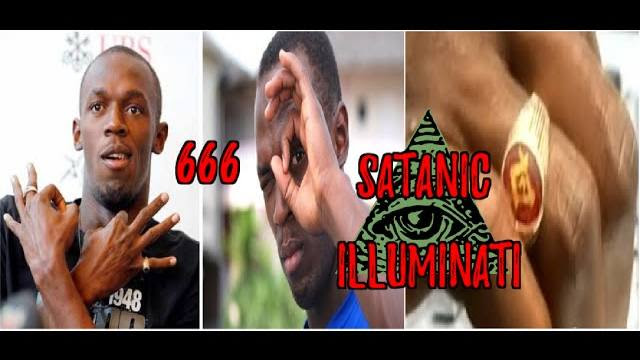
The Illuminati Flame
After President Kennedy’s assassination in 1963, the ScottishRite of Freemasonry erected
an obelisk there at Dealey Plaza and topped it with a depiction of the
Illuminati flame. On his grave in Arlington Cemetery they lighted an
“eternal flame” which still burns to this day.
Over the Pont de L’Alma tunnel in Paris where Princess Diana was
murdered after crashing into the 13th pillar, the Illuminati erected a
huge golden torch/flame sitting atop a black pentagram.
On the island where Diana lies buried was placed yet another depiction of the Illuminati flame. “The
Brotherhood is telling us that they killed Kennedy and Diana, but
unless you understand their symbolic language, you don’t know.” David Icke, “The Biggest Secret” (352)
At ground-zero of the World Trade Center shortly after 9/11 they lit another “eternal flame” for the victims.
Overlooking the fallen World Trade Center buildings in New York Harbor stands the Freemasonic Statue of Liberty also
holding up the Illuminati torch. Another few blocks away in Rockefeller
Center, the Rockefellers erected a huge golden statue of Prometheus
carrying the lighted torch.
This Illuminati symbol is found on the dime, the D.I.A. seal,
Indiana’s seal, the symbol of the Olympic Games, CBN, The National
Front, The Better Business Bureau and many other places where the
Brotherhood’s fingers have delved.
“The
torch, of course, the Olympic torch, is the torch of Prometheus, the God
who stole fire for the service of man. And, again, as we said, in New
York in front of Rockefeller Plaza you will see the statue of
Prometheus, holding in his hand a flame, the torch, the fire of
revolution. The dime, of course, on the Mercury head dime, inscripted on
the back of the dime you will find the torch of illumination. It’s
still there today. The modern American dime has the torch of
illumination.
The
Statue of Liberty has the torch. Of course, on all universities and
colleges we find in their symbols and emblems that they have the
torches, symbolically standing for illumination of the Illuminati. As a
matter of fact, when you are a graduate from a university you become an
Alumni, which is taken from, obviously, Aluminati, Illuminati.
Emphasizing that you become illuminated when you go to a university. The
torch is also used in the Amoco Oil logo. It is found many, many
places.”
Jordan Maxwell, “Matrix of Power”
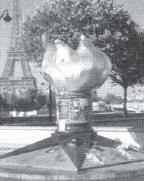
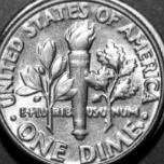
“Their
most used symbols are the lighted torch, the symbol of knowledge and the
Sun. When an initiate reaches a certain level in the pyramid they are
said to be ‘illuminated,’ more symbolism of the lighted torch. One of
the recurring stories in the ancient world is of a hero figure who takes
fire (knowledge) from the ‘gods’ and gives it to the people the chosen
few people, that is … At the Rockefeller Center in New York today is a
gold statue of Prometheus (gold, the solar metal of the gods) and he is
holding the light, the fire, in line with the legend. To the
Rockefellers this is not just a statue; it is a symbol of the whole scam
they are involved in.”
David Icke, “The Biggest Secret” (351)
Following the
Illuminati torch symbol begins to unravel a larger mystery. The
Brotherhood Goddess Isis/Semiramis holds the torch of enlightenment in
the Statue of Liberty as well as the Columbia Pictures and Columbia
Records logo.
Columbia
University’s symbol is also the torch/flame. CBS, “Columbia”
Broadcasting System’s logo is the all seeing eye of the Illuminati.
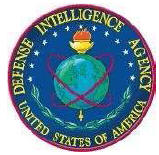
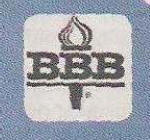
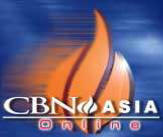

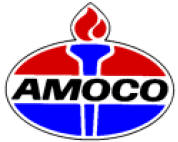
The capital
of the United States is Washington D.C. which stands for “District of
Columbia.” America was discovered by a man named Columbus. The Fraternal
order Knights of Columbus have been exposed aided the drug trade in
Columbia the country.
Columbia is the NASA space shuttle that blew up. Columbine is the high school that suffered the mass shootings.
What is going on here!?
“It goes
back to a group of Freemasons that came to this country before the
founding of our constitution, who were called the Colombians, known as
the Colombian faction. They founded what we know as Columbia University.
Out of that has come Columbia space shuttle, Columbia Pictures, and
Columbia Broadcasting, CBS, with the all seeing eye on the pyramid as
their symbol.
As a
matter of fact, our government, our so-called government, is not even a
part of our country. It is in an area called the District of Columbia,
It is a separate district, not part of America at all. The simple truth
behind that fact is that there was a section of the geography in this
country that was set aside by a very powerful group of Freemasons,
called the Colombian faction, working behind the scenes during the
founding of this country.”
Jordan Maxwell, “Matrix of Power”
The fourth
and highest degree emblem in the Knights of Columbus depicts a
dive-bombing white dove. The French word for dove is “Colombe.”
Sacrificial doves, representing virgins were known in Masonic circles as
theColumbe.
Many of the British royal crowns/scepters are topped with the white dove.
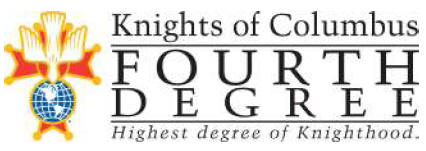
This is the same royalty that gave us the pseudonym “Christopher Columbus” as the man who “discovered” America.
“The
Statue of Liberty is the symbolic image of the goddess worshipped by the
Illuminati bloodlines since they were based in Babylon (and before).
She goes under many names, including Queen Semiramis, the ‘branch
bearer’, who was symbolized as a dove …When the Illuminati bloodlines
moved their headquarters to Rome, the goddess was worshipped as Venus
Columba or ‘Venus the Dove’. The French word for dove is still colombe.
This is why a man who signed his name ‘Colon’ is known to official
history as ‘Columbus’. He was bearing the branch of the dove into the
Americas in 1492 and was given this symbolic name relating to the
Illuminati goddess.”
–David Icke, “Tales From Time Loop”
“The
symbols of the three main political parties in the United Kingdom which
serve the structure headed by the Queen are the lighted torch
(Conservatives), the red rose (Labor) and the dove (Liberal Democrats)!
At the time of writing their three leaders are Tony Blair (Bilderberg
Group), William Haig (Bilderberg Group), and Paddy Ashdown (Bilderberg
Group). Just a coincidence, nothing to worry about.”
David Icke, “The Biggest Secret” (363)
Sourceshttp://www.bibliotecapleyades.net/secret_teachings/sta43.htm




